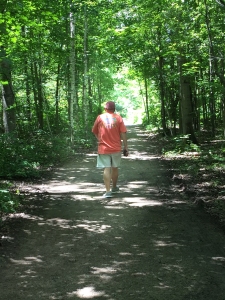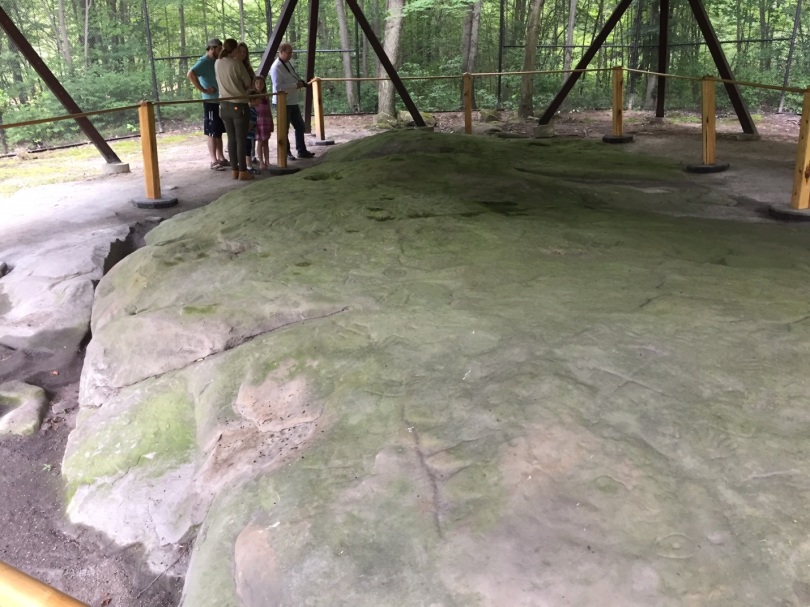43.6503° N, 83.0308° W
Cass City, Michigan
Sanilac Petroglyphs Historic State Park
By Dale Hemmila
She: “We need to go and see the petroglyphs.”
Me: “Um, okay, what is a petroglyph?”
She: “You’ll see when we get there.”
Me: “Where is there?”
“We’ll take a ride in the country,” she said. “It’ll be fun,” she said.
And that’s how I found myself one nice summer day smack dab in the middle of Michigan’s Thumb staring at an eight-sided barn, after having forked over 10 bucks for the privilege, and which, by the way, is definitely not a petroglyph. But I’m getting ahead of the story here; more barn babble to come.

Now, as it turns out, Michigan’s Sanilac Petroglyphs have their own state park, which contains Michigan’s only known rock carvings attributable to Native Americans. It’s not known when these carvings were created but estimates are between 300 and 1,000 years ago, and they are believed to have been carved by the Great Lakes Anishinabek (original people). The drawings offer a glimpse into Michigan’s prehistoric past.
So, how did we get to see them and what about that barn?
Well my wife and fellow partner in adventure, Patti, had heard about the petroglyphs some time ago and wanted to see them for herself. So she hatched the idea of a nice weekend drive, which is how I found myself whizzing past corn fields and passing through a windmill farm to try to find the Sanilac Petroglyphs Historic State Park. Despite the somewhat remote location, Patti, with the help of Google Maps, was able to navigate our way to Germania Road near Cass City in Sanilac County to the state park.
Because of the subject matter and the location of the park I was expecting to find few additional humans viewing the petroglyphs. That just shows you how wrong I can be.
As we arrived at the site, the parking lot was full, with cars spilling out onto the side of the road to park.
Huh, I said to myself. This must be a much bigger deal than I had reckoned.

We quickly added our vehicle to the roadside and began the short walk down the trail to the petroglyph site. Just as we were about to reach the pavilion that housed the rock carvings, we were stopped by a member of the park staff.
It was our lucky day, he claimed–or not. It seems that one day each year a group of local Native Americans honor their heritage by holding a ceremony at the site. Today, of all the 365 choices, was the day for 2017. He indicated we could enter the pavilion quietly and wait for the end of the ceremony (about an hour) or, as luck would have it, we were only 15 minutes away from “Michigan’s famous Octobarn.” Then he smiled as if he had just presented us with our lottery winnings.
Now, as I mentioned at the top of this story I knew nothing about the petroglyphs. I also knew exactly the same amount about Michigan’s “famous Octobarn.” Despite that lack of knowledge and not wanting to intrude on the ceremony taking place only a few steps away, we decided we would find our way to discover the Octobarn.
As we found out, Octobarn is shorthand for the Thumb Octagon Barn Agricultural Museum located in rural Tuscola County. The site is an agricultural museum and

educational center featuring several restored, yet functional, out buildings and an additionally restored farmhouse featuring the furnishings and details of the early 1920s.

The barn itself, though, is the center of attention. Standing 70 feet tall and covering nearly a quarter of an acre, the barn indeed has eight sides. It seems the original owner of the farm, one James Purdy, had seen a similar structure on a trip to Iowa and decided he wanted one just like it. Dubbed an “Air Castle” when construction was completed in 1924, the barn was touted as the barn of the future as its octagonal shape allowed for more square footage for the same amount of building material as a conventional barn.
I don’t know about all that, but it is the most unique barn I have ever seen. Not that I’ve seen that many barns, but still. Evidently, though, it didn’t quite turn out to be the

barn of the future.
In addition to the barn and farmhouse, scattered about the grounds are other historical buildings that are still in use such as a blacksmith shop, a sugar shack and a sawmill, with an additional display of many early 20th century farm implements.
Visitors can tour the entire site for $5 per person. Tours are conducted by retiree-volunteers who live onsite in travel trailers during the summer.
All in all it proved to be an interesting diversion, but doggone it, we came to see petroglyphs, so after we collected our free gift from the gift shop (yes there IS a

gift shop), we hightailed it back to the Sanilac Petroglyphs Historic Site.
As we arrived, the Native American ceremony had just wound down and the participants were making their way out, which gave us free rein to enter the pavilion and, at long last, we would see us some petroglyphs.
And we did.
The primitive drawings are carved into a soft sandstone rock formation that rises low out of the earth and is now protected by the pavilion roof. Over the centuries while unprotected, the rain, wind, frost and even human touch caused the images to fade, however, some remain distinct. Birds, animals, swirls and even what appears to be a person with a bow and arrow are quite visible.

Under study by archeologists since the 1920s, the images are significant links to an oral history handed down through generations. The images also have a strong spiritual significance that reaches across hundreds of years to the current generation of Native Americans. For the ancient Native Americans their history is literally “carved in stone.”

So whether you have an interest in the prehistoric past or you’re into early 20th century history a drive past the farms and windmills into the middle of Michigan’s Thumb can provide substantial insight, with the benefit of two visits for the cost of one.


i live just down the street form the petroglyphs for the last 14 years. My kids have loved going there for years, even though they have heard all of the stories many times.
LikeLike